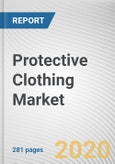The world protective clothing market is expected to register substantial growth during the forecast period owing to an increase in concerns toward worker’s safety. Stringent U.S. governmental regulations regarding the safety of workers such as Occupational Safety and Health Act (OSHA) and Flammable Fabrics Act under the Consumer Product Safety Commission also drive this market, boosting the demand for protective fabrics from several end-user industries such as building & construction and healthcare.
The report segments the protective clothing market on the basis of material type, application, end-user industry, and region. On the basis of material, the market is divided into aramid & blends, polyolefin & blends, polybenzimidaloe (PBI), cotton fibers, laminated polyesters, and others. According to application, it is categorized into thermal, mechanical, chemical, biological/radiation, and others. On the basis of end user industry, it is segmented into oil & gas, construction & manufacturing, pharmaceutical/medical, law enforcement & military, firefighting, and others. Region wise, the market is analyzed across North America, Europe, Asia-Pacific, and LAMEA.
North America holds the largest market share due to stringent safety regulations in the U.S. Comprehensive competitive analysis and profiles of major market players such as E. I. du Pont de Nemours and Company, Lakeland Industries, Inc., Ballyclare Limited, 3M Company, Koninklijke Ten Cate NV, Teijin Limited, Workrite Uniform Company, Inc., Cetriko S.L., W.L. Gore & Associates, Inc., and Glen Raven Inc.
KEY BENEFITS FOR STAKEHOLDERS
- The report provides an extensive qualitative and quantitative analysis of the current trends and future estimations of the market from 2020 to 2027 determine the prevailing opportunities
- A comprehensive analysis of the factors that drive and restrict the growth of the market is provided
- The market size is provided in terms of revenue
- Porter’s five forces analysis helps to analyze the potential of buyers & suppliers and the competitive scenario of the industry for strategy building
- Profiles of leading players operating in the market are provided to understand the competitive scenario
- The report provides extensive qualitative insights on the significant segments and regions exhibiting favorable growth
KEY MARKET SEGMENTS
By Material Type
- Aramid & Blends
- Polyolefin & Blends
- Polybenzimidaloe (PBI)
- Cotton Fibers
- Laminated Polyesters
- Others
By Application
- Thermal
- Mechanical
- Chemical
- Biological/Radiation
- Others
By End-Use Industry
- Oil & Gas
- Construction and Manufacturing
- Pharmaceuticals/Medical
- Military and Defense
- Firefighting
- Others
By Region
- North America
- U.S.
- Canada
- Mexico
- Europe
- Germany
- France
- Italy
- Spain
- UK
- Rest of Europe
- Asia-Pacific
- China
- Japan
- India
- South Korea
- Rest of Asia-Pacific
- LAMEA
- Brazil
- Saudi Arabia
- South Africa
- Rest of LAMEA
Key Market Players
- DuPont
- Lakeland Industries, Inc.
- Ballyclare Limited
- 3M Company
- Koninklijke Ten Cate NV
- Teijin Limited
- VF CORPORATION
- Cetriko S.L.
- W.L. Gore & Associates, Inc.
- Glen Raven Inc.
The other players in the value chain include Lion Apparel Inc., Globe Manufacturing Co. LLC, PBI Performance Product Inc., Workrite Uniform Company Inc., Logistik Unicorp Inc, VF Imagewear, Inc., Globus Ltd., Kermel Industries, Newtex Industries, Inc., Hydrowear B.V., Protective Industrial Products, Inc., Alpha Pro Tech, Ltd., Radians, Inc., National Safety Apparel, and others.
Table of Contents
Companies Mentioned
- DuPont
- Lakeland Industries Inc
- Ballyclare Limited
- 3M Company
- Koninklijke Ten Cate NV
- Teijin Limited
- VF Corporation
- Cetriko SL
- WL Gore & Associates Inc
- Glen Raven Inc
Methodology
The analyst offers exhaustive research and analysis based on a wide variety of factual inputs, which largely include interviews with industry participants, reliable statistics, and regional intelligence. The in-house industry experts play an instrumental role in designing analytic tools and models, tailored to the requirements of a particular industry segment. The primary research efforts include reaching out participants through mail, tele-conversations, referrals, professional networks, and face-to-face interactions.
They are also in professional corporate relations with various companies that allow them greater flexibility for reaching out to industry participants and commentators for interviews and discussions.
They also refer to a broad array of industry sources for their secondary research, which typically include; however, not limited to:
- Company SEC filings, annual reports, company websites, broker & financial reports, and investor presentations for competitive scenario and shape of the industry
- Scientific and technical writings for product information and related preemptions
- Regional government and statistical databases for macro analysis
- Authentic news articles and other related releases for market evaluation
- Internal and external proprietary databases, key market indicators, and relevant press releases for market estimates and forecast
Furthermore, the accuracy of the data will be analyzed and validated by conducting additional primaries with various industry experts and KOLs. They also provide robust post-sales support to clients.

LOADING...









